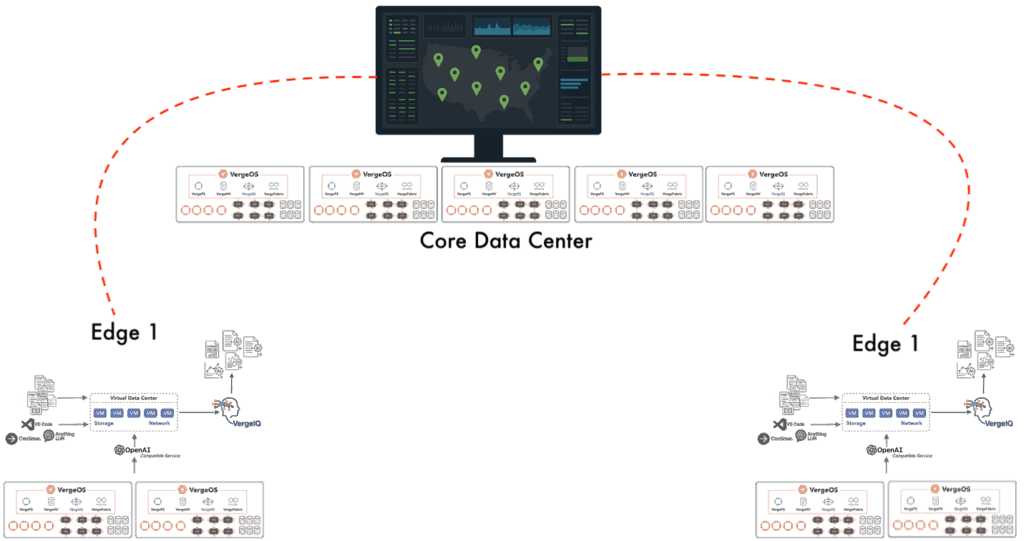In his recent blog, “Edge AI and IoT: AI’s Hidden Infrastructure Problem”, Keith Townsend (@CTOAdvisor) explains why edge AI fails. The low success rate is not due to the models themselves. It is due to the fragmented layers of firmware, drivers, and operating environments that underlie them. As Townsend points out, this infrastructure stack creates complexity, spread across diverse hardware at multiple sites. It leads to an operational environment where drift is inevitable, upgrades are inconsistent, and performance is unpredictable. Without a disciplined approach to managing these stacks, edge AI pilot projects rarely transition into stable, scalable production deployments.
VergeIQ, Private AI for Core Data Centers and the Edge

That’s the exact problem VergeIQ is built to solve. VergeIQ is a private, enterprise-class service that provides a complete AI pipeline. It delivers everything from data ingestion and preparation to model training, inference, and lifecycle management.
VergeIQ is embedded directly into VergeOS. It benefits from an infrastructure platform that integrates virtualization, storage, networking, and now AI into a single, cohesive operating environment. It eliminates the multiple, disconnected layers that create drift and operational friction. This unified design allows AI workloads to operate in the same secure, version-controlled environment as other critical enterprise applications.
Edge AI Requires Centralized, Integrated Infrastructure
In VergeOS, AI is a service, like file services: you simply turn it on. There’s no need to provision VMs, deploy containers, or manage separate orchestration layers.
Because AI capabilities are native to VergeOS, IT can provision Virtual Data Centers (VDCs) as siloed AI environments. Each VDC operates with its own isolated compute, storage, and networking resources. The AI “service” can be assigned to whichever VDCs need it. VDCs enable predictable AI performance and security without interfering with other workloads.

At the recent Future of Memory and Storage (formerly Flash Memory Summit) event, the VergeOS architecture enabled us to set up three separate AI environments in under an hour. This install time included physical setup, power-on, and connectivity verification. These environments ran as private, self-contained edge AI deployments, without relying on the show’s network. The result is an operational model where AI deployments are as fast to launch as they are secure and repeatable.
Real-Time Inventory and Observability
One of the reasons edge AI fails is that IT struggles to maintain accurate visibility into what is running where. Unknown infrastructure stacks are unmanageable, and without complete telemetry, infrastructure teams are blind to drift until it causes failures. VergeOS addresses this problem with ioMetrics. It captures real-time data about hardware configurations, firmware and driver versions, and operating system builds. This comprehensive view enables the immediate detection of deviations, ensuring that every edge environment remains in a known, validated state.
For organizations managing dozens—or even hundreds—of remote AI deployments, VergeOS’s Sites Dashboard extends that visibility into operational control. Sites Dashboard provides a single, centralized interface for monitoring and managing all VergeOS-powered edge locations in real-time. Platform teams can apply updates, adjust configurations, enforce security policies, and spin up or tear down environments across the entire deployment footprint without needing to send personnel on-site.
Edge AI Requires Secure, Unified Deployment
Security is another reason why edge AI fails. At the edge, physical access to devices and diverse deployment locations create an expanded attack surface. VergeIQ enforces secure boot processes, validates firmware integrity, and uses signed binaries for all components in the infrastructure stack. Each VDC is treated as an immutable artifact that has been validated in staging before being rolled out to production. If an update introduces instability, built-in rollback capabilities allow teams to revert to a known good state with minimal disruption. Because VergeOS integrates AI, it eliminates the need for separate orchestration layers or container clusters. The result is faster time-to-value and a reduced operational burden for platform teams.
Edge AI Requires Vendor-Neutral Acceleration
A common trade-off in edge AI is the choice between predictability and portability. Vendor-integrated stacks, such as those tied to a specific GPU vendor, can simplify lifecycle management. However, they introduce long-term lock-in, creating another reason why edge AI fails. VergeIQ supports heterogeneous accelerators, including NVIDIA, AMD, and other specialized processors—without compromising the ability to manage them consistently. Resource orchestration, clustering, and pooling are handled by VergeOS, allowing AI workloads to run optimally across almost any hardware mix. VergeOS flexibility enables organizations to design hardware strategies that align with business needs, rather than adhering to the vendor’s roadmap.
Abstraction Without Losing Control
Hardware standardization is not always possible in edge environments. The edge must adapt to local constraints, legacy equipment, or specific workload requirements. VergeIQ provides a uniform abstraction layer over diverse hardware, ensuring that AI behaves predictably regardless of the underlying platform. This is not an abstraction for its own sake. It is grounded in a lifecycle-managed infrastructure stack that is versioned, tested, and enforced across the entire deployment footprint. By controlling the infrastructure stack while abstracting its differences, VergeIQ enables both operational consistency and hardware flexibility. StorageSwiss explores the value of this kind of integrated approach to infrastructure in its article, “Why Hyperconverged Infrastructure Needs More Than Just Compute and Storage.”
Why VergeIQ Delivers Where Others Struggle
VergeIQ embodies the principle that infrastructure discipline must come before orchestration. By unifying AI workloads with the same Infrastructure Platform that runs enterprise applications, IT:
- Standardizes and collapses the infrastructure stack
- Maintains real-time observability
- Secures the entire lifecycle
- Enables portable acceleration strategies
These outcomes transform edge AI from a fragile, site-by-site experiment into a predictable, centrally managed platform that can scale without operational chaos.
See VergeIQ in action.
Join our webinar, “Introducing VergeIQ – Enterprise AI Infrastructure”, to learn how you can simplify, secure, and scale your AI deployments from edge to core.
Register here.



